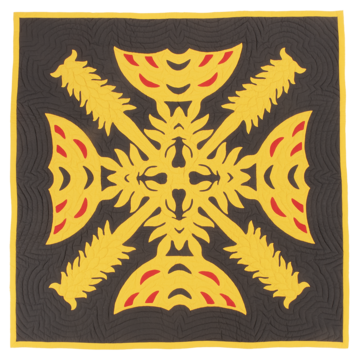Stories around a Feather Cloak
At the Pitt Rivers Museum in Oxford, England, you can see a beautiful Ahu’ula, a feather cloak from Hawaii. It is on display on the ground floor, in a case that has a curtain covering the glass, which when drawn back reveals the striking yellow, red and black design worked in tiny feathers. Draw back the curtain to see the feather cloaks on display and read the interpretation to learn how these Ahu ‘ula (cloaks) were used to reinforce political and diplomatic transactions, solidify relationships, and engender obligations. This feather cloak inspired the original commission for the Poakalani Quilting group, who went on to make fifteen quilts for the museum, which are on display in the special exhibition, Hawai'i Ma uka to Ma kai: Quilting the Hawaiian Landscape. Read below for more information about a quilt that was created in response to this Ahu‘ula.
Listen to a series of discussions around the feather cloak at the museum by Hawaiian historians, biologists and a music professor in recordings available as four episodes online.
Join Research Curator, Marenka Thompson-Odlum in conversation with Melissa Price, Takuma Itoh, Sheila Conant, and in a group discussion with Shirley Buchanan, Susan Corley, Catherine Imaikalani Ulep and Uluwehi Hopkins, to learn about the birds whose feathers went into these cloaks, how the cloaks were made, and their significance for Hawaiians.
https://w.soundcloud.com/player/?url=https%3A//api.soundcloud.com/playlists/1614987733&color=%23100c04&auto_play=false&hide_related=false&show_comments=true&show_user=true&show_reposts=false&show_teaser=true&visual=true
Melissa Price is an Assistant Professor at the University of Hawaii at Manoa in Honolulu and developed the innovative education programme, the Symphony of the Hawaiian Birds which seeks to raise public awareness of Hawaii’s endangered species.
Takuma Itoh is an Associate Professor of Music at the University of Hawaii at Manoa in Honolulu, and his Vanished Voices tells the story of the now extinct Kaua’i O’o last heard in 1987.
Sheila Conant is a biologist and Professor Emerita at the University of Hawaii.
Shirley Buchanan is a lecturer at the University of Hawaii at Manoa who teaches in the History Department as well as the Women, Gender and Sexuality Studies Department at Manoa, and has a focus on Indigenous histories in America.
Susan Corley is an independent scholar on Hawaiian history and author of 'Leveraging Sovereignty', a political history of Kamehameha III.
Catherine Imaikalani Ulep is a PhD candidate at the University of Minnesota Twin City researching Makaʻāinana Wāhine history.
Uluwehi Hopkins is lecturer in the History Department at the University of Hawaii West O’ahu Campus.

Nā Mea Aliʻi Wahine (Queens/Chiefess). Quilted by Nobuko Nakagawa. Designed by John Serrao. PRM 2022.57.15
This quilt is on display in the current special exhibition at the Pitt Rivers Museum, Hawai'i Ma uka to Ma kai: Quilting the Hawaiian Landscape. It features a design of an ahu‘ula, inspired by the feather cloak on display at the museum.
Although ahu‘ula are primarily associated with male chiefs and royalty the phrase Nā Mea Aliʻi Wahine actually translates to Queens/Chiefesses. The quilt was named in recognition of Kekāuluohi who gifted the cloak currently at the museum to Sir George Simpson of the Hudson Bay Company in 1841 for services rendered to the Hawaiian Kingdom. Kekāuluohi was a powerful ali‘i who served as Kuhina Nui (second-in-command) during the reign of King Kamehameha III and helped draft the first Hawaiian constitution.
Stories from the Poakalani Quilting Circle
by Nobuko Nakagawa
In 2000, I started living in Hawaii with my husband. A friend took me to the Poakalani quilting class which was my introduction to Hawaiian quilting. I learned how to make quilt from Cissy Serrao and how to design from John Serrao. In 2001, I started designing quilts on my own and in 2006, I obtained my instructor's license and returned to Japan. Sharing the profound and vast culture of Hawaii with Japanese students through Hawaiian quilts is truly enjoyable.
When I first laid eyes on the Nā Mea Aliʻi Wahine design, the keyword "history" came to mind. That's why I wanted to try making a quilt with the same material as the ones ancient Hawaiian women used to make. Polyester fibres were first introduced in 1953. Quilts made before that used cotton for both the batting and thread. I experimented several times and ended up using cotton batting from Mexico and cotton thread from Canada. The fabric, however, is made in Japan.
The quilt made entirely of cotton materials was slightly heavier and lacked elasticity compared to those made with polyester. However, through this small project of reproducing an old quilt, I was able to gain a lot of knowledge and satisfy my curiosity. My mentor, John Serrao told me to study Hawaiian culture well, and those words have become my driving force.




